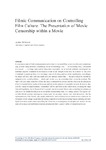Mostrar o rexistro simple do ítem
Filmic communication on controlling film culture. The presentation of movie cersorship within a movie
| dc.contributor.author | Withalm, Gloria | es_ES |
| dc.date.accessioned | 2014-10-02T12:31:15Z | |
| dc.date.available | 2014-10-02T12:31:15Z | |
| dc.date.issued | 2012 | es_ES |
| dc.identifier.citation | Culture of communication / Communication of culture, 2012: 2133-2145. ISBN: 978-84-9749-522-6 | es_ES |
| dc.identifier.isbn | 978-84-9749-522-6 | es_ES |
| dc.identifier.uri | http://hdl.handle.net/2183/13306 | |
| dc.description.abstract | [Abstract] A constitutive part of both communication and culture is the possibility to act in a free and unrestricted way, without being censored. Censorship, the act of censoring a text — be it a literary text, a newspaper or a movie —, is a large topic and its discussion necessarily has to include political, sociological and economic aspects in addition to the analysis of the actual changes of the text. As a matter of fact, even if confined to censoring films, it is too large a topic to be discussed in a short contribution. Accordingly, the paper will deal only with one small and very special subject that — though it might be considered marginal to the overall problem — sheds light on the view on censorship from within the medium: The paper will give some examples of how the issue is presented in movies and thus focus on the discussion of self-referential filmic modes of discourse and not on the analysis of censorship as such. In order to deal with the variety of manifestations, ‘censorship’ will be used here in the widest sense, covering the range from selfregulation, that is forms of self-imposed control, to actual direct state censorship (in advance as well as on the finished product) or to its milder contemporary form of a rating system. The agents will be both official censors, working on a large scale for an entire country, and local authorities, like the representatives of the Church, who simply ordered the local exhibitors to cut certain scenes, otherwise the population of the village would hear the strong disapproval of the movie during Sunday morning services. Apart from these stories about controlling the filmic text, a second group of examples will include the rare cases of an actual and deliberate onscreen presentation both visual or verbal of censorial practices. | es_ES |
| dc.language.iso | eng | es_ES |
| dc.publisher | Universidade da Coruña | es_ES |
| dc.title | Filmic communication on controlling film culture. The presentation of movie cersorship within a movie | es_ES |
| dc.type | info:eu-repo/semantics/conferenceObject | es_ES |
| dc.rights.access | info:eu-repo/semantics/openAccess | es_ES |






